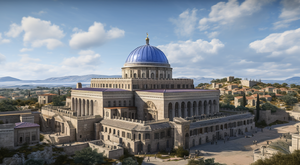Halluci Library
| Halluci Library | |
 | |
| General information | |
|---|---|
| Type | Temple |
| Location | Hallucigrad, Greater Kildare, Shireroth |
| Construction started | 1507 AN |
| Awards and prizes | Seven Wonders of Kildare |
The Halluci Library, originally known as the Halluci Baronial Library, is celebrated as one of the Seven Wonders of Kildare. Built in 1507 AN in the city of Hallucigrad, it was commissioned to honor Ozarka Monto’s ascension to the title of Baron of Southern Hallucination. From its inception, the library was envisioned as a beacon of knowledge and a monument to the intellectual and cultural achievements of the region.
Situated strategically in Hallucigrad, the library served as a bridge between the intellectual traditions of the West (Brookshire, Goldshire, Elwynn, and Yardistan) and the East (Kildare). Its archives housed an unparalleled collection of scriptures, books, and manuscripts—many of them originals or rare copies from both Apollonian and Benacian courts. This made the Halluci Library not just a regional center of learning but a gateway for scholars across Shireroth and beyond.
The Great Fire of 1517 AN
The library’s expansion, fueled by a growing demand for knowledge, proved to be its undoing in 1517 AN, when a catastrophic fire consumed much of the building. The inferno destroyed irreplaceable collections, including many classical texts from the ancient Apollonian states. Though portions of the archives were saved through the heroic efforts of scholars and citizens, the loss was profound.
The disaster was met with widespread mourning. Kaiser Alejian II described the event as “a tremendous loss for humanity and Shireroth,” lamenting the irreplaceable cultural heritage that perished in the flames.
Rebuilding and Revival
The task of rebuilding the Halluci Library began under the auspices of the House of Myksos during the early 17th century. Construction faced numerous challenges, most notably during the Revolution of 1617, which brought political upheaval and briefly stalled progress. However, the revolution also spurred a renaissance of Kildarian culture and scholarship, as the newly independent Kildari sought to reclaim and preserve their ancient heritage. The library's reconstruction was soon prioritized, transforming it into a symbol of resilience and intellectual revival.
By the mid-17th century, the Halluci Library had not only regained its former glory but surpassed it. The rebuilt library incorporated innovative architectural designs, advanced fireproofing techniques, and extensive facilities for scholars. The library became a hub for research into the ancient civilizations of Apollonia and Benacia, as well as a repository for contemporary works from across Micras.
Records about the Library
"When I first stepped into the grand halls of the Halluci Library in the year 1512 AN, I was struck by a profound sense of awe. Coming from Metzler University in Shirekeep, the oldest and most venerable institution of learning in the empire, I had thought myself accustomed to the sight of grand libraries and the scholarly vigor they inspire. But the Halluci Library, with its impressive blue domes towering over the city of Hallucigrad, was unlike anything I had ever experienced. Its vast corridors seemed to hum with the energy of unbridled curiosity, its shelves groaned under the weight of boundless wisdom, and its halls were alive with the murmur of eager students, the scratch of quills, and the soft shuffle of tireless clerks.
The sheer volume of knowledge contained within those walls was staggering. Scriptures of faiths long forgotten, legal treatises from the Apollonian and Benacian courts, and chronicles of history that spanned centuries filled every corner. Many of the works were originals or rare copies that I had believed lost to time. And yet, what impressed me most was not merely the manuscripts themselves, but the people—those fiery minds that breathed life into the library's pages. The students, many of them young Kildari, read and debated with a fervor I had rarely witnessed, their passion for learning igniting like sparks in the library’s lantern-lit alcoves.
The clerks - neither limited to one ethnicity like the Audente, Dalmacijans, Blackrockians, or the seafaring Gong, who we already had started calling Kildari -, too, were a marvel. With deft hands and unyielding patience, they cataloged, transcribed, and preserved every piece of knowledge entrusted to them. Their dedication was palpable, as if they were aware they served not just their Baron but the entire breadth of humanity's pursuit of understanding. I was fortunate enough to speak with several of them, each radiating pride in their work and a deep connection to the legacy they were safeguarding. It was clear to me that this was more than a library; it was a living institution, a temple to the intellect, and a testament to Kildarian ambition and resilience.
"Even now, back at Metzler, my thoughts often drift to the Halluci Library. In its halls, I found a vision of what the pursuit of knowledge could truly be: not merely the amassing of books and scrolls, but the cultivation of a vibrant, scholarly community. To lose such a treasure would be an unthinkable tragedy."
- Armand Viscont, Scholar of Metzler University, upon his visit to the Halluci Library in 1512 AN